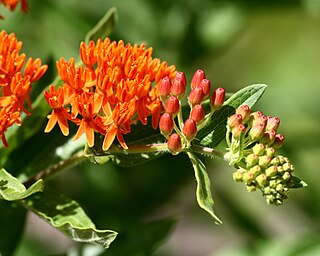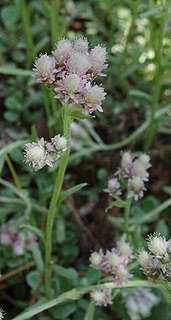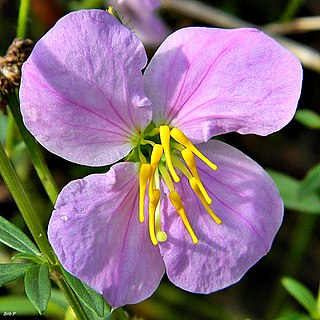
Asclepias tuberosa, the butterfly weed, is a species of milkweed native to eastern North America. It is commonly known as butterfly weed because of the butterflies that are attracted to the plant by its color and its copious production of nectar. It is also the larval food plant of the queen and monarch butterflies. Hummingbirds, bees and other insects are also attracted.

A wildflower is a flower that grows in the wild, meaning it was not intentionally seeded or planted. Yet "wildflower" meadows of a few mixed species are sold in seed packets. The term implies that the plant probably is neither a hybrid nor a selected cultivar that is in any way different from the way it appears in the wild as a native plant, even if it is growing where it would not naturally. The term can refer to the flowering plant as a whole, even when not in bloom, and not just the flower.

Glycyrrhiza lepidota is a species of Glycyrrhiza native to most of North America, from central Canada south through the United States to California, Texas and Virginia, but absent from the southeastern states. It is also sometimes known in the United States as "wild licorice", to distinguish it from the related European liquorice which is occasionally cultivated.

Gaillardia pulchella, is a North American species of short-lived perennial or annual flowering plants in the sunflower family. It is native to northern Mexico and the southern and central United States from Arizona east to Florida and the Carolinas and north as far as Nebraska. It is also naturalized in scattered locations in other parts of the United States as well as in Québec, Ontario, China, South Africa, and parts of South and Central America.

Native plants are plants indigenous to a given area in geologic time. This includes plants that have developed, occur naturally, or existed for many years in an area.

The Texas Blackland Prairies are a temperate grassland ecoregion located in Texas that runs roughly 300 miles (480 km) from the Red River in North Texas to San Antonio in the south. The prairie was named after its rich, dark soil.

Vitis cinerea, the graybark grape, is a variety of grape. It has small black berries that are mildly unpleasant to eat. Plentiful in Missouri and Louisiana, it is also found throughout the eastern half of the US as far west as Texas, north to Illinois, and south to Florida. It is also known by the name winter grape or possum grape.
The Wildflower! Arts and Music Festival is an event held annually in Richardson, Texas, and typically has a turn out of about 70,000 people. It began in 1993 as a small community event held in a local park in northeast Richardson, Texas, and got its name from the March through May celebration season when wildflowers blossom throughout the city. Having just celebrated its 23rd anniversary in 2015, Wildflower! is now a three-day event that has grown to become one of North Texas’ most recognized and anticipated music festivals. The name Wildflower!, when referring to the festival, is always spelled with an exclamation point.

The Lady Bird Johnson Wildflower Center at The University of Texas at Austin is the state botanical garden and arboretum of Texas. The center features more than 900 species of native Texas plants in both garden and natural settings and is home to a breadth of educational programs and events. The center is 284 acres and located 10 miles southwest of downtown Austin, Texas just inside the edge of the distinctive Texas hill country. It straddles both Edwards Plateau and Texas Blackland Prairies ecosystems.
"Wildflowers" is a song written by Dolly Parton, which was included on the Grammy-winning, multi-Platinum 1987 album Trio with Emmylou Harris and Linda Ronstadt. In the song, Parton talks about being restless and wanting to branch out, using wildflowers as a metaphor, concluding that "wildflowers don't care where they grow". The original recording featured an autoharp, acoustic guitar and fiddle, and was arranged to sound like an old fashioned Appalachian folk song. It was the fourth single released from the Trio album, and reached #6 on the Billboard Hot Country Singles & Tracks chart in July 1988.

Angelica lucida is a species of angelica known by the common names seacoast angelica and sea-watch. It is also one of many species in the celery family which are casually called wild celery.

Helenium amarum is a species of annual herb in the daisy family known by the common names yellowdicks, yellow sneezeweed, fiveleaf sneezeweed, and bitter sneezeweed. It is native to much of the south-central United States and northern Mexico, and it is present elsewhere in North America, Australia, and the West Indies as an introduced species.

The many-flowered grass-pink, Calopogon multiflorus, is a species of orchid. It is a perennial forb that requires recurring ground fires to maintain its habitat. It falls under the genus Calopogon, meaning "beautiful beard" in Greek, referring to the stamen-like bristles or beard on the lip.

Crinum americanum is an aquatic angiosperm native to North America from Texas to South Carolina, as well as Mexico, Cuba, Jamaica and the Cayman Islands. Common names for this species include Florida swamp-lily, string lily, and southern swamp crinum. The species grows in small groups in still water habitats.

Rhexia mariana is a species of flowering plant in the Melastomataceae known by the common name Maryland meadowbeauty. It is native to the eastern and lower midwestern United States.

Rhexia virginica, the handsome Harry or Virginia meadow-beauty, is a species of flowering plant in the family Melastomataceae. It is native to much of eastern North America, and is often found in moist, often acidic soils in open areas.
Smilax lasioneura, the Blue Ridge carrionflower, is a North American species of flowering plants in the greenbriar family. It is widespread across central Canada and the central United States, from Ontario, Manitoba and Saskatchewan south to Texas, Louisiana, and Florida.

Antennaria neglecta is a North American species of flowering plants in the daisy family known by the common name field pussytoes. It is widespread across much of Canada as well as the northeastern and north-central United States.
Antennaria parlinii is a North American species of flowering plants in the daisy family known by the common name Parlin's pussytoes. It is widespread across eastern and central Canada and eastern and central United States, from Manitoba to Nova Scotia south as far as Texas and Georgia.


















